In 1967, Roger Patterson and Robert Gimlin spotted, and filmed, or so they claimed, a Sasquatch next to Bluff Creek in California. Dubbed an elaborate hoax by many, this image has become the universal symbol for Bigfoot throughout the United States. But, is Bigfoot real? A better question would be to ask why mainstream science has failed to put the question to the test when it comes to not only Bigfoot, but to other cryptids as well. Science is duty-bound by definition to explain the unexplained, yet some people are still debating the existence of Bigfoot rather than examining emerging scientific evidence, some of which has come to light in unexpected places.
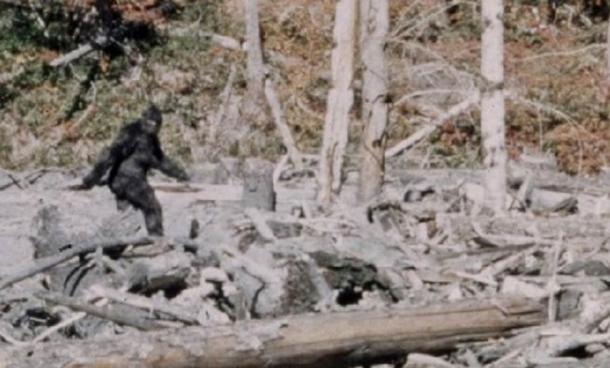
Iconic frame 352 from the Patterson-Gimlin film which gave a face to the now popular cryptid creature known as Bigfoot. Despite emerging evidence, people continue to ask: Is Bigfoot real? (Bob Gimlin / YouTube)
New Bigfoot Evidence from Washington State: Tooth and Bite Marks
One of these places is Mount St. Helens in Washington State. In 2013 and 2014, along with one of my former college students, I located three different ungulate rib prey bone assemblages (elk and deer rib bones) that had seemingly inexplicable chewing marks left in them. We conducted a two year Zooarcheological field research project, which culminated at the 69th Annual Anthropological Research Conference on March 26, 2016.
At the conference I presented our conclusions to a room full of respected academic and governmental anthropologists and archeologists, in the form of incisor, molar and pre-molar dental signature evidence that we were able to very carefully link with current scientific literature describing historical and contemporary hominin chewing evidence. This published, peer-reviewed literature described a diagnostic framework for accurately separating and identifying hominin mastication evidence recovered from both pre-archaic sites and comparative contemporary chewing studies upon ungulate rib bones.
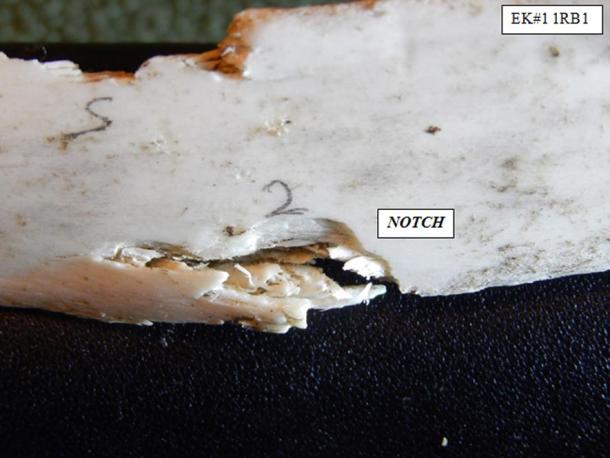
As part of Bigfoot-related evidence presented at the 2016 conference, Mitchel Townsend presented a new category of incisal dentition signature termed “a notch.” (Author provided)
Hominin Mastication Activity Discovered on Bones
Furthermore, we proposed the evaluation of a new category of incisal dentition signature termed a “notch,” which consolidated the applicable literature and accurately described some of our field research evidence. The conference gave us a chance to demonstrate the links between the tooth marks that we recovered in the field, with current peer reviewed scientific research covering the same subject. This current research provided a framework by which we could compare our tooth mark descriptions. It also helped provide a very effective tool that enables scientists to re-examine other suspected human chewing evidence upon bones.
All three locations contained the same evidence profiles of ungulate (deer and elk) rib evidence with clear and measurable evidence of hominin mastication activity. The dentition of other known local ecosystem specific predators and scavengers was compared against Homo sapiens dentition. Of the 25 total hominin incisor measurements taken from all three sites, 92% are outside the average lateral incisors size range for modern Homo sapiens . In this same sample, 80% are outside the average measurement for central incisor. From this evidence, Upper Inter-Canine measurements can be accurately estimated. All of the comparative analysis demonstrated hominin dentition physio-morphology of at least two times the size of modern humans.
The evidence was clear and consistent across all three locations. The teeth marks and jaw shapes of bear, cougar, humans, porcupine, and wolverine along with every other potential species that might have been responsible was examined and eliminated or included. After identifying the teeth marks as Hominin, we measured the geometry of the individual marks and were able to determine that they were primarily outside the upper size range for current humans. From these measurements we were able to estimate mouth size, which again was over double the size of a modern human .
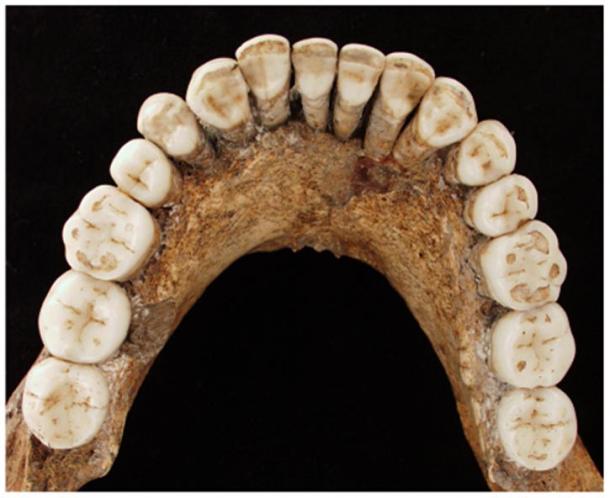
Fossil jaw of Neanderthal. (P Sémal /Royal Belgian Institute of Natural Sciences)
Rib Peeling as Evidence of Hominin Mastication
The Pre-Molar and Molar dentition signature evidence analysis is perhaps the strongest indication of hominin mastication evidence that emerged from the field research. The current peer-reviewed scientific literature describes Rib Peeling as a clear hominin assigned bone surface modification diagnostic characteristic. The physical act of rib peeling entails putting a rib in a hominins mouth and using their hands as levers to move the rib in cooperation with using their pre-molars and molars to masticate the ends.
This specific force application procedure has been evaluated over several peer-reviewed studies both pre-archaic and contemporary as clearly diagnostic of hominin mastication activity. This process creates specific secondary dentition signatures in consistent hemispherical regions of masticated ungulate rib specimens. The pre-molar impressions were triangular in shape while the molar evidence is characterized by double arch shapes. The evidence recovered from all three sites demonstrated clear and consistent rib peeling evidence.
The physical act or process of Rib Peeling is very simple. It consists of using your hands to put a rib in your mouth and using those same hands to move the end of the rib around as you chew on the opposite end. This creates very specific damage and tooth marks in predictable locations on a rib. It also creates secondary tooth marks in expected locations. This predictable combination of damage and individual teeth mark impression evidence is clearly supported in current scientific research and is an accurate tool that enables the separation of hominin verses predator chewing evidence in bones.
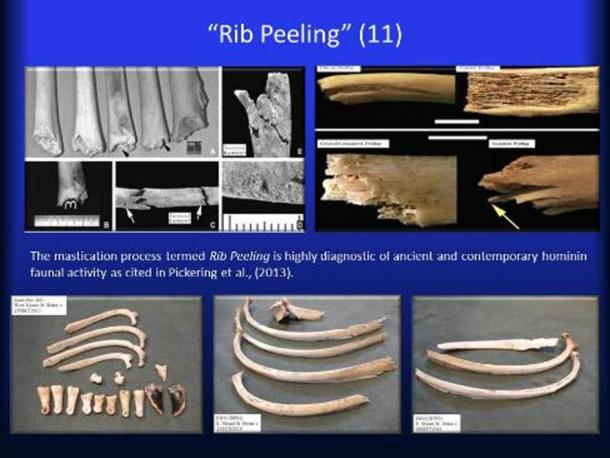
Rib Peeling. (Author provided)
Bone Stacking and Other Hominin Behavior
Behavioral evidence analyzed from each site supported the forensic evidence. A review of the applicable scientific literature also demonstrated that ungulate ribs were a central and connecting theme. We have proposed the addition of three behavioral manifestations or categories illuminated by the neoichnological analysis of the supplementary data. All three are fundamentally connected to ungulate rib mastication evidence.
The first is called Bone Stacking and has a very long history in hominin evolution. In the case of our data, bone stacking was present at all three locations. We propose and the literature supports the assertion that hands are required to accomplish this behavior. The second revolves around prey of choice. Ungulate ribs were statistically the most prevalent bone evidence preservation medium recorded in all of the literature examined. Contemporary chewing studies initiated to understand hominin mastication strategies have all produced ungulate rib evidence in alignment with pre-archaic studies. The overall prevalence of this type of bone evidence modification medium is a central theme throughout the literature and the field evidence recovered from Mount St. Helens.
The final behavioral expression that we illuminated centered upon the behaviors associated with Rib Peeling. Rib Peeling is a behavioral act that requires hands to accomplish. As previously described it requires putting a rib in a hominins mouth and using hands as levers to help apply additional forces during mastication activity. This association of hands and rib peeling is clearly supported in the literature and the analyzed field data. The central themes throughout that emerged were the statistically high incidence of ribs, the requirement of hands, and the assignment of associated dentition evidence coordinated with behavioral evidence as a reliable diagnostic framework for assessing potential hominin attributed mastication activity in bones.
Humans throughout time have behaved in certain predictable ways when selecting food and processing these foods. The accurate coordination of physical evidence with behavioral evidence is a well-developed field in criminal science. We were able to demonstrate a clear connection throughout our research with the physical evidence. This connection was clearly centered upon the use of hands, eating in a predictable manner, and selecting ungulate species as a primary food source.
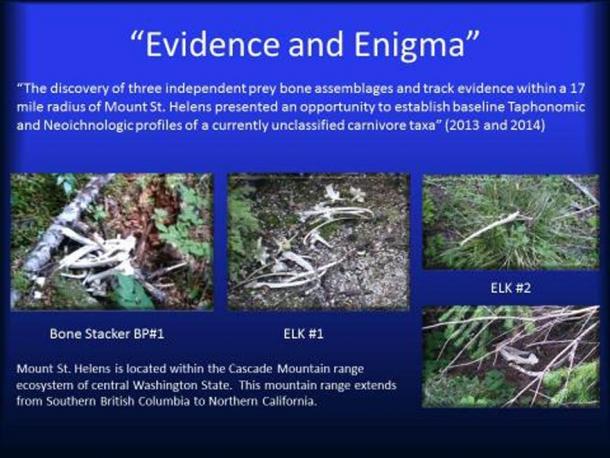
Bone stacker evidence presented. (Author provided)
What Does It All Mean? Is Bigfoot Real?
The conclusions generated by a careful analysis of the applicable peer reviewed literature and a cross comparison of the field data enable the construction of a currently unclassified hominin profile. The dentition evidence demonstrates hominin incisor measurements primarily outside the possibility of Homo sapiens. Evidence based reconstruction of inter-canine distances demonstrate a measurement that is over two times the size of a modern human’s mouth.
The statistically high presence of rib peeling and required associated supplementary regionally located evidence is perhaps the strongest indication of hominin dentition mastication evidence. The behavioral evidence mutually supported the forensic dentition evidence and is further confirmation of reliability across the applicable literature and field evidence profiles. When taken in totality both the Neoichnology and Taphonomy evidence is mutually supporting and grounded in applicable peer-reviewed literature. The data is mutually supporting and clearly illuminated in the current literature. The conclusions are accurate, well supported, repeatable, and construct physical and behavioral profiles of a currently unclassified hominin living ( Bigfoot) at Mount St. Helens.
The evidence and analysis that I presented at the 69th Annual Anthropological Research Conference represented an opportunity for mainstream anthropologists and archeologists to examine part of the credible evidence that is slowly emerging. The Zooarcheological field research project that we conducted used the most current scientific theories and analytical techniques to illuminate data that clearly constructs a profile of a hominin with associated dentition physio-morphology and definable behavioral characteristics. Our conclusions are based upon clear and repeatable data grounded in and supported by contemporary peer reviewed science. They refer too, build upon and expand currently accepted mainstream scientific theory.
The anthropological research conference gave those in attendance the opportunity to hear our conclusions and review the evidence we based them upon. They had a chance to analyze our process and framing theories. The audience’s reaction to our presentation was one of encouragement and astonishment. Attendees were very encouraged by our comprehensive efforts and broad based analysis. They were astonished by the results.
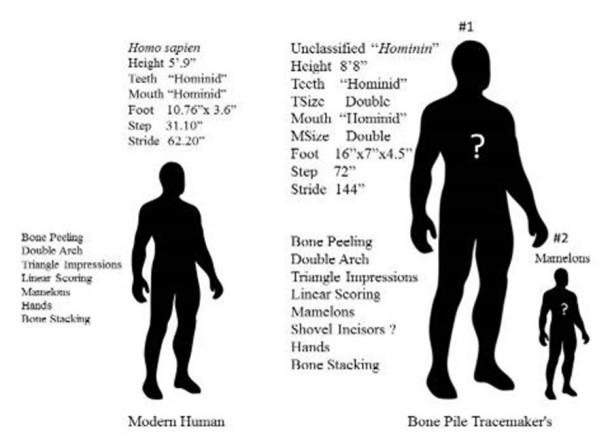
Conclusions image from Mills and Townsend 2016. (Author provided)
Comprehensive Bigfoot Investigations Required
As we emerge full circle, once again we are faced with the central question of why mainstream science has failed to comprehensively examine the possible existence of what some people refer to as Bigfoot. Credible multi-disciplinary evidence continues to emerge from unlikely places, yet in general it has failed to attract the professional scientific attention it deserves. By conducting this type of transparent research, writing a paper, and presenting it at a prestigious academic conference we hope to encourage deeper analysis of our own conclusions as well as inspire further scientific attention into the questions that surround the possibility of a giant, unclassified hominin living and thriving in the Pacific Northwest .
Our research has provided a place to begin for those willing to take up the task and put credible evidence to the test. At the end of the day why are we still asking the same question: “is Bigfoot real”? We encourage the scientific community to move beyond their skepticism in order to conduct deep examination of our efforts as well as that of others in this emerging area of research. Science has an obligation by definition to explain the unexplained, whatever that may be. By presenting our conclusions at a prestigious anthropological research conference and authoring this article I hope to highlight a place where researchers can start.
Top image: Why is the scientific community still stuck on asking “is Bigfoot real” rather than conducting scientific analysis of the evidence. Source: ginettigino / Adobe Stock
Updated April 6, 2021.
References
Chu, S. J. (2007). Range and mean distribution frequency for individual tooth width of the maxillary anterior detention. Journal of Practical Procedures and Aesthetic Dentistry, 19, 209-215.
Lyman, R. L. (2009). What taphonomy is, what it isn’t, and why taphonomists should care about the difference. Retrieved from [Online] Available here.
Fernandez-Jalvo, Y., & Andrews, P. (2010, August 4). When humans chew bones. Journal of Human Evolution, 60, 117-123. http://dx.doi.org/10.1016/j.jhevol.2010.08.003
Harvati, K., Darlas, A., Bailey, S., Rein, T. R., El Zaatari, S., Fiorenza, L., Psathi, E. (2012, February 1, 2013). New neaderthal remains from mani peninsula, southern greece: the kalamakia middle paleolithic cave site. Journal of Human Evolution, 1-14(14), 1-14. http://www.academia.edu/10788830/New_Middle_Palaeolithic_sites_from_the_Mani_peninsula_southern_Greece
Pickering, T. R., Dominges-Rodrigo, M., Heaton, J. L., Yraveda, J., Barba, R., Bunn, H. T., … Brain, C. K. (2012, June 26). Taphonomy of ungulate ribs and the consumption of meat and bone by 1.2 million-year-old hominins at olduvai gorge, tanzania. Journal of Archaeological Science, 40, 1295-1309. http://dx.doi.org/10.1016/j.jas.2012.09.025
Saladie, P., Rodriguez-Hidalgo, A., Diez, C., Martinez-Rodriguez, P., & Carbonell, E. (2012, February 13). Range of bone modifications by human chewing. Journal of Archaeological Science, 40(), 380-397. http://www.sciencedirect.com/science/article/pii/S0305440312003524
Townsend, M. N., & Mills, G. (2016, March). Using forensic biotic taphonomy dentition signature analysis and neoichnology profiling to determine the identity of the predator responsible for the deposition and mastication of three independent ungulate rib prey bone assemblages in the mount st. helen’s ecosystem of the cascade mountain range: a zooarcheology field application case study. Paper presented at the 69th Annual Anthropological Research Conference, Tacoma, WA. Retrieved from https://onedrive.live.com/?cid=25bbcabf2de517ff&id=25BBCABF2DE517FF!123&authkey=!AE9vh_ZHn84PpUw
Viegas, J. (2012). Prehistoric people ate each other, bones show. Retrieved from http://news.discovery.com/history/archaeology/cannibalism-early-humans-bones-101213.htm
Related posts:
Views: 0
 RSS Feed
RSS Feed
















 April 7th, 2021
April 7th, 2021  Awake Goy
Awake Goy  Posted in
Posted in  Tags:
Tags: 
















